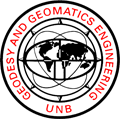Release Date: January 13, 1998
NEW CONCURRENT DEGREE PROGRAM OFFERS POTENT COMBINATION
TO GEOMATICS & INFO TECH MARKETS
Beginning September 1998, the University of New Brunswick in Fredericton will offer a new program that will give students an edge in the geomatics and information technology markets.
Graduates of the concurrent degree program in computer science and geodesy and geomatics engineering will be ready to fill the high demand that exists around the world for specialists in these areas.
"Employers in geomatics systems manufacturing and information technology firms across North America and Europe simply can't find enough capable people who combine an in-depth computer science education with an understanding of satellite positioning, mapping, remote sensing and geographic information systems," says David Coleman, chairperson of UNB's Department of Geodesy and Geomatics engineering. "There's no question that this new program is going to be demanding. We're selectively aiming it at high achievers, and the job opportunities throughout the program and on graduation promise to be tremendous."
Graduates of the new program will receive two degrees: a bachelor of computer science and a bachelor of science in engineering.
"Canada is a world-class competitor in building computer systems to handle geographically referenced information," says Brad Nickerson, a computer science professor at UNB. "This concurrent degree program will prepare graduates capable of increasing Canada's competitive edge in this market."
Both partners in this program are already well-known in their own right. UNB's Faculty of Computer Science is the first of its kind in Canada, and now teaches over 600 undergraduate and 50 graduate students. It has a strong co-operative education program with more than 75 employers, and is currently increasing the number of faculty members and dedicated laboratories for computer science instruction.
The Department of Geodesy and Geomatics engineering is recognized worldwide as one of North America's largest centres for research and teaching in this area. It currently enrols over 60 graduate students from more than 20 countries studying geodesy, global positioning system, geographic information systems, engineering surveys, land information management and ocean mapping.
The concurrent program will contain the core and elective course requirements of both the computer science and geodesy and geomatics engineering programs. Graduates will be eligible for accreditation as an Information Systems Professional (ISP) and registration as a Professional Engineer in Canada.
"Demand already exceeds supply for UNB's CS and GGE graduates but we aren't prepared to rest on our laurels," says Dr. Coleman. "We're hoping this new concurrent program will develop graduates who are prepared to take a leading role in the geomatics and information technology developments that are emerging in the marketplace."
Pending approval by the Maritime Provinces Higher Education Commission, the program is accepting applicants for admission next September.
Further information about the concurrent program is available from UNB's Department of Geodesy and Geomatics engineering at (506) 453-4698 or Faculty of Computer Science at (506) 453-4566. A special WWW page describing the program is located at http://www.cs.unb.ca/bcsbse.html.


